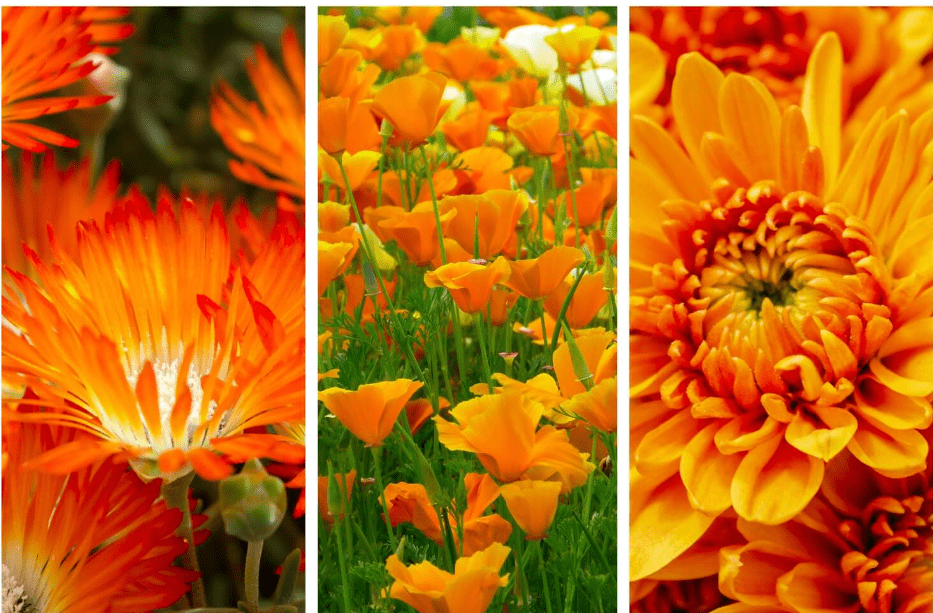
Orange flowers are like sunshine in your garden. They’re bright, cheerful, and have a way of making you smile. Beyond their pretty looks, orange flowers also carry a powerful message. They symbolize excitement, joy, and friendship. Imagine a garden filled with these vibrant blooms – it’s like having a constant party outside your door!
Choosing the Right Orange Flowers
Picking the perfect orange flowers for your garden isn’t just about color. You also need to think about where you live and how much time you want to spend caring for them.
- Know your soil, sun, and water: Different flowers like different things. Some love full sun, while others prefer a bit of shade. Some need lots of water, while others can handle dry spells.
- Safety first: Some orange flowers can be toxic to humans or animals. It’s important to know which ones are safe to have around kids and pets.
A Rainbow of Orange Blooms
Now, let’s talk about the fun part: picking out your orange flowers! There are so many beautiful options to choose from.
Orange Blossom (Citrus sinensis)

The orange blossom is the fragrant flower of the Citrus sinensis tree, also known as the sweet orange. It is the state flower of Florida and has long been associated with good fortune, often included in bridal bouquets.
Orange blossoms have numerous uses:
The flowers are used to make orange blossom essence, an important component in perfumes
Orange blossom petals can be made into a delicately citrus-scented “orange blossom water” or “orange flower water,” used in French and Middle Eastern cuisines, especially in desserts and baked goods.
In Spain, fallen blossoms are dried and used to make orange tea
Orange blossom honey (or citrus honey) is obtained by placing beehives in citrus groves while the trees bloom, allowing bees to pollinate seeded citrus varieties
The orange blossom has a strong scent with citrus notes and sweet, soapy undertones. It is an evergreen plant with dark green, oval leaves and can grow up to 20-30 feet tall. Orange trees are commonly used for ornamental purposes, especially in the Mediterranean region, where they have historically been valued for their fragrance and beauty.
Lantana (Lantana camara)
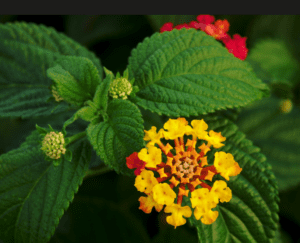
Lantana camara, commonly known as lantana, is a flowering plant belonging to the Verbena family (Verbenaceae). It is native to the American tropics, specifically Central and South America, but has become an invasive species in many regions worldwide after being introduced by European explorers in the 18th century. The plant can thrive in various ecosystems and has spread to over 50 countries, often outcompeting native flora and reducing biodiversity.
Description
Lantana camara is a perennial shrub that typically grows tall between 0.5 to 2 meters (1.5 to 6.5 feet). It can form dense thickets and, under optimal conditions, may reach heights of up to 6 meters (20 feet). The leaves are broadly ovate, opposite, and emit a strong odor when crushed.
The plant produces small, tubular flowers arranged in clusters and can exhibit a range of colors, including red, yellow, pink, and orange. These flowers change color as they mature, which is believed to enhance pollination efficiency by signaling to pollinators.
The fruit of Lantana camara is a berry-like drupe that matures from green to dark purple. The unripe fruits are toxic to humans and animals, and ingestion can cause serious digestive issues due to the hard spikes on their surface. Each plant can produce up to 12,000 fruits, contributing to its rapid spread.
Orange Lily (Lilium bulbiferum var. croceum)
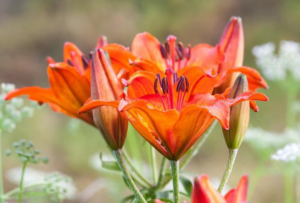
Lilium bulbiferum var. croceum typically grows to 20 to 80 centimeters. The plant features ovoid bulbs with large, pointed scales that are whitish. Its erect stems bear lanceolate leaves, and the inflorescence can produce one to five short-haired flowers. The blooming period extends from May through July, making it a prominent feature in gardens and natural habitats during summer.
This lily thrives in various environments, particularly in sub-Mediterranean mountain regions. It can be found in meadows, subalpine pastures, and the edges of forests, particularly in oak, chestnut, and beech woods. The preferred soil type is loose, loamy-clay, rich in calcium and organic matter, often found in medium-deep, well-drained conditions.
Pansies (Viola x wittrockiana)
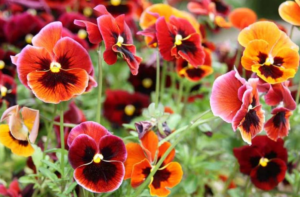
Pansies, scientifically known as Viola × wittrockiana, are popular flowering plants cherished for their vibrant colors and unique “face-like” appearance. Depending on the climate, they belong to the Violaceae family and are often grown as annuals or short-lived perennials.
Characteristics of Pansies
- Appearance: Pansies feature five petals, typically measuring between 1 to 3 inches in diameter, and come in a wide array of colors, including purple, yellow, blue, white, and even black. Many varieties exhibit a distinctive dark central blotch, enhancing their visual appeal.
- Growth Habit: These plants usually grow to a height of 6 to 12 inches and can spread 6 to 12 inches wide, forming a compact mound that is suitable for various garden settings, such as flower beds, borders, and containers.
- Native Habitat: Pansies are native to Europe and western Asia, thriving in cooler climates.
Flowering Maple (Abutilon x hybridum)
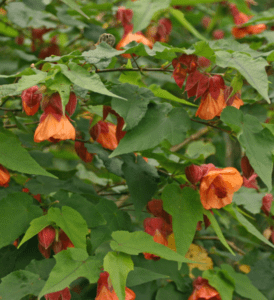
Abutilon x hybridum, commonly known as Flowering Maple, is a hybrid group within the Malvaceae family. This plant is characterized by its attractive, maple-like leaves and vibrant, pendulous flowers. Here’s a detailed overview of its characteristics, cultivation, and care.
General Characteristics
- Common Names: Flowering Maple, Chinese Lantern, Parlor Maple, Albution
- Family: Malvaceae
- Origin: This hybrid is derived from various South American species, particularly Abutilon darwinii and Abutilon striatum.
Orange Tulips (Tulipa spp.)
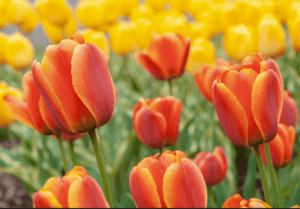
Orange tulips (Tulipa spp.) are a vibrant and expressive addition to any garden. They are members of the lily family (Liliaceae) native to southern Europe and central Asia.
Orange tulips come in various shades and shapes, from bright tangerine to deep burnt orange. They have a goblet-shaped flower with six petals (tepals) that can be slender, pointed, or broadly rounded.
Some cultivars include:
‘Orange Princeps‘: A new early-flowering variety with large orange blooms
‘Queensday’, ‘Triple A‘, ‘Royal Ad Rem’, ‘Ad Rem Parrot’, ‘Avignon Parrot’, ‘Lorenzo’: Orange parrot tulips with ruffled, fringed petals
Orange tulips grow 4 to 28 inches tall and bloom in middle to late spring. They prefer full sun, fertile, well-drained soil, and a winter chill period. While tulips are often grown as annuals, species of tulips, and some hybrids can return year after year.
Butterfly Weed (Asclepias tuberosa)

Butterfly weed (Asclepias tuberosa) is a milkweed species native to eastern and southwestern North America. It is a perennial plant that grows 1-3 feet tall and is known for its bright orange, yellow, or red flowers that bloom from April to September.
Key facts about butterfly weed:
It is commonly known as butterfly weed because it attracts many butterflies, especially monarchs, with its nectar-rich flowers. The flowers also attract other pollinators like bees, moths and hummingbirds.
Unlike other milkweeds, butterfly weed does not have milky sap. Its stems are hairy but not milky when broken.
It prefers dry, well-drained soil and full sun exposure. It is drought tolerant and grows well in poor soils.
Butterfly weed is easy to grow from seed but can take 2-3 years to reach flowering size. It does not transplant well due to its deep taproot.
The plant contains toxic compounds like glycosides, alkaloids and resinoids that can cause weakness, seizures and eye injuries in humans and animals. Use is contraindicated in pregnancy and with infants.
Native Americans and pioneers used the roots to treat diarrhea, respiratory illnesses and pleurisy. The seed pods were also eaten as food after boiling.
Butterfly weed is a popular garden plant, especially in butterfly gardens, meadows and mixed borders.
It combines well with plants like coneflowers, asters and purple flowers.
In summary, butterfly weed is a showy, drought-tolerant native plant that provides nectar for butterflies and is a host plant for monarch caterpillars, making it a valuable addition to gardens and natural areas.
Chinese Lantern (Physalis alkekengi)
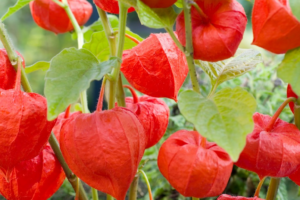
Chinese Lantern, scientifically known as Physalis alkekengi, is a perennial plant belonging to the nightshade family (Solanaceae). It is widely recognized for its striking orange, lantern-like calyces that encase small berries, making it a popular garden ornamental choice.
Appearance
The Chinese Lantern plant typically grows between 20 to 39 inches tall, depending on the variety. It features ovate leaves and produces creamy-yellow, bell-shaped flowers during the summer months (July to September). After flowering, the plant develops its distinctive orange to brick-red calyces, which eventually decompose into a skeletal structure, revealing the small berries inside.
Toxicity
All parts of the plant are toxic, particularly the unripe berries, which can be harmful if ingested. It is advisable to wear gloves when handling the plant to avoid skin irritation.
Oriental Poppies (Papaver orientale)

Oriental poppies, scientifically known as Papaver orientale, are striking herbaceous perennials belonging to the Papaveraceae family. Native to regions like the Caucasus, northeastern Turkey, and northern Iran, these plants are celebrated for their large, vibrant flowers and unique foliage.
Physical Characteristics
Oriental poppies typically grow to 2 to 4 feet (60 to 120 cm) and can spread between 1 to 2 feet (30 to 60 cm). They feature a mound of hairy, finely dissected leaves forming a spring rosette. The flowers are notable for their cup-shaped blooms, which can reach up to 6 inches (15 cm) across, displaying colors such as orange, red, pink, and even purple or white, often with a dark blotch at the base of the petals.
Blooming Period
These poppies bloom primarily in late spring to early summer, typically from May to July. The flowers last for about 10 days before fading, after which the foliage dies back during the hot summer months, allowing the plant to conserve moisture.
Calendula (Calendula officinalis)
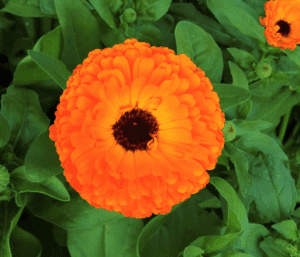
Calendula officinalis, commonly known as pot marigold, is a flowering plant in the Asteraceae family, native to southern Europe but widely cultivated in various temperate regions. This herbaceous perennial is characterized by its vibrant yellow and orange flowers, which can bloom throughout the year in suitable conditions. The plant typically grows to a height of 1 to 2 feet and features oblong-lanceolate leaves that are hairy on both sides.
Description
- Family: Asteraceae
- Genus: Calendula
- Species: C. officinalis
- Common Names: Pot marigold, common marigold, Mary’s gold
The flowers of Calendula officinalis are known for their ornamental and culinary uses. They are edible and have a slightly bitter, tangy flavor, often used to add color to salads and dishes. Additionally, the flowers can be dried and used to create a natural dye
Montbretia (Crocosmia ‘Lucifer’)
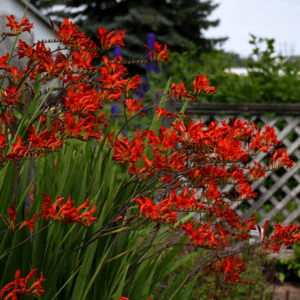
Crocosmia ‘Lucifer’ (Montbretia) is a showy and exotic-looking perennial that produces decorative clumps of erect sword-shaped leaves and brilliant wands of fiery scarlet red tubular flowers. It is probably the most widely grown cultivar of Crocosmia, blooming for 5-8 weeks from mid to late summer.
Some key facts about Crocosmia ‘Lucifer’:
It is native to South Africa and hardy in USDA Zones 5-9
The flowers are a magnet for hummingbirds and butterflies
It grows 2-4 feet tall and 1-2 feet wide
Crocosmia ‘Lucifer’ prefers full sun but will tolerate partial shade
The corms should be planted 3 inches deep and 6-8 inches apart
It grows well in average, moist but well-drained soil
Crocosmia ‘Lucifer’ can spread aggressively and may become a nuisance in some gardens if not manage
Canna Lily (Canna spp.)
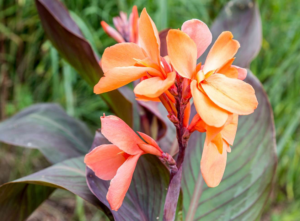
Canna lilies, scientifically known as Canna spp., are vibrant, herbaceous perennials belonging to the family Cannaceae. They are native to the tropical regions of Central and South America but have been widely cultivated and naturalized in various parts of the world, including Europe and Africa, since the 1860s.
Characteristics
Canna lilies are known for their large, attractive foliage and striking flowers, which can be found in various colors, including red, pink, yellow, orange, and cream. The flowers are produced in clusters atop tall stems and are particularly appealing to hummingbirds and butterflies.
The leaves of the canna plant are broad and paddle-shaped, resembling those of banana plants, and can exhibit a range of colors from green to dark purple or bronze, often with variegated patterns.
Zinnias (Zinnia spp.)
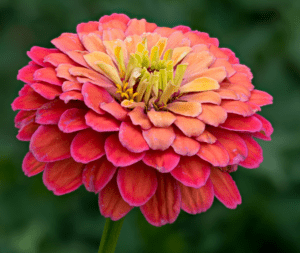
Zinnias, belonging to the genus Zinnia and part of the Asteraceae family, are popular annual flowering plants known for their vibrant colors and ease of cultivation. They are native to Mexico and Central America and have become a favorite in gardens worldwide due to their low maintenance and prolific blooming from late spring through the first frost.
Description
Zinnias exhibit various flower colors, including red, yellow, pink, orange, purple, and white. The flowers can be single, double, or semi-double, varying heights from about 6 inches to 3 feet, depending on the species and cultivar. Zinnia elegans and Z. angustifolia are the most commonly cultivated species, with Z. elegans being particularly favored for its large, showy blooms.
Trumpet Vine (Campsis radicans)

Campsis radicans, commonly known as trumpet vine or trumpet creeper, is a vigorous, deciduous woody vine native to eastern North America. It belongs to the Bignoniaceae family and is recognized for its striking trumpet-shaped flowers, which typically bloom from summer through early autumn. The flowers are predominantly orange or red, measuring about 3 inches (8 cm) long, and are particularly attractive to hummingbirds and other pollinators.
Description
Trumpet vine can grow up to 30-40 feet (9-12 meters) in length, climbing structures or trailing along the ground. It features pinnate, dark green leaves that can be glossy above and dull beneath. The plant is known for its aggressive growth, utilizing aerial rootlets to cling to surfaces, potentially damaging wood, stone, and brick structures.
New Guinea Impatiens (Impatiens hawkeri)

New Guinea impatiens, scientifically known as Impatiens hawkeri, is a flowering plant belonging to the Balsaminaceae family. This species is native to Papua New Guinea and the Solomon Islands and was first collected in 1884. It has since been hybridized to create a variety of cultivars that are popular in gardens for their vibrant colors and adaptability to different lighting conditions.
Characteristics
New Guinea impatiens typically grow to a height of 12 to 20 inches and have a bushy, mounding form. They are known for their striking, large flowers that come in a range of colors, including pink, red, orange, and white. The foliage can also be variegated, adding to their ornamental appeal. These plants are particularly valued for their ability to thrive in shady areas, making them ideal for gardens with limited sunlight.
Nasturtium (Tropaeolum majus)
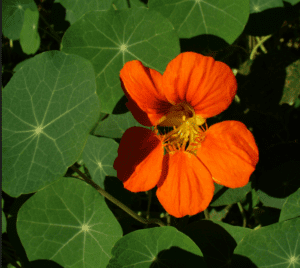
Nasturtium (Tropaeolum majus) is a popular annual or short-lived perennial flowering plant native to South America. It is known for its distinctive leaves, bright flowers, and peppery flavor.
Description
Nasturtium has creeping or sprawling stems that can reach up to 6 ft (1.8 m) long. The leaves are large, nearly circular, 1 to 6 in (3 to 15 cm) in diameter, with a shield-like shape and the petiole attached near the center. The leaves can be green, glaucous green, or variegated with white.
The flowers are 2.5 to 6 cm wide, funnel-shaped, and come in a range of colors, including yellow, orange, red, and cream. They may be single, double, or lightly marked with a second color. The flowers have a refreshing, mild fragrance.
Bittersweet Berries (Celastrus scandens)

Celastrus scandens, commonly known as American bittersweet, is a perennial vine native to eastern and central North America. It is recognized for its vigorous growth and distinctive ornamental fruits, which have made it a popular choice in gardens, despite its invasive tendencies in some areas.
Description
American bittersweet is a robust, deciduous vine that can reach lengths of up to 30 feet (9.1 meters). The stems are typically yellowish-green to brown and can twine around other vegetation, which may inhibit the growth of nearby plants. The leaves are ovate, finely serrated, and turn a striking pale yellow in the fall.
The vine produces small, scentless flowers in clusters, primarily in late spring to early summer. The female plants bear round, orange-yellow fruits that split open in the fall, revealing scarlet seeds. These fruits are attractive and serve as a food source for birds, although they are toxic to humans if ingested.
Mexican Sunflower (Tithonia rotundifolia)
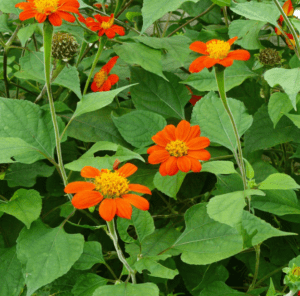
The Mexican sunflower, scientifically known as Tithonia rotundifolia, is a plant in the Asteraceae family native to the warmer and moister parts of North America. It is an annual plant in USDA zones that is more excellent than Zone 10. It grows up to 1.5 meters tall and has orange or red daisy-like flowers.
The leaves are deltoid to lanceolate, occasionally lobed, up to 38 cm long and 30 cm wide, with a subentire, crenate, or serrated margin. The lower leaves are usually three-lobed. The flower heads have a diameter of 5 to 8 (rarely up to 10) centimeters, with vermilion red ray flowers and golden yellow disc flowers.
Crown Imperial (Fritillaria imperialis)

The Crown Imperial (Fritillaria imperialis) is a majestic and regal bulbous perennial known for its towering height and stunning pendant bells. It commands attention and adds a touch of grandeur to garden landscapes.
Description
Features a tall, upright stem topped with a ‘crown’ of bell-shaped flowers
Grows in an erect form with stout stems and a robust, imposing presence
It can reach heights of 1-1.5 meters (3-5 feet), making it a standout addition to any garden
The bell-shaped flowers are downward-facing, usually bright orange or red, though there are also yellow varieties
Flowers have a slightly musky odor that deters pests
Large, glossy leaves form whorls along the stem below the flower cluster
Typically blooms for 2-3 weeks in mid to late spring
Daylilies (Hemerocallis spp.)
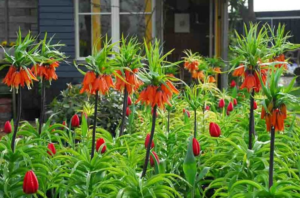
Scientifically known as Hemerocallis, Daylilies are perennial plants renowned for their striking flowers and adaptability. The name Hemerocallis translates from Greek to “beautiful for a day,” which aptly describes the ephemeral nature of their blooms—each flower lasts only a single day. Still, they bloom in succession, providing a prolonged display from late spring to early autumn.
Botanical Characteristics
Family: Hemerocallidaceae
Height: Typically ranges from 1 to 1.5 feet (30 to 45 cm), although some cultivars can grow taller.
Foliage: The plants have narrow, arching leaves that can be evergreen or deciduous, depending on the species and cultivar.
Flowers: The blooms come in various colors, including yellow, orange, red, pink, purple, and white. They can be single or double, and their shapes vary from trumpet-like to star-shaped, with sizes reaching up to 8 inches (20 cm) across.
Begonias (Begonia spp.)
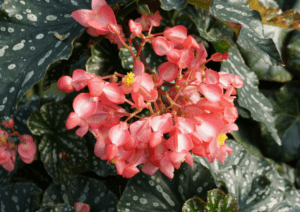
Begonias are a diverse and popular genus of flowering plants comprising over 1,800 species and hybrids. They are primarily native to tropical and subtropical regions, making them a favorite for both indoor and outdoor gardening. Known for their vibrant flowers and unique foliage, begonias thrive in shaded or partially shaded areas, making them ideal for brightening darker spots in gardens and homes.
Types of Begonias
Begonias can be categorized into several main groups based on their root structure and growth habits:
Fibrous-rooted (Wax Begonias): These are common garden varieties with thick, waxy leaves and smaller flowers. They are hardy and can tolerate more sun than other types. Famous for mass plantings and borders.
Tuberous Begonias: Known for their spectacular, large blooms in bright colors, these begonias have fleshy tubers. They are often used in containers and garden beds, blooming from mid-summer to fall.
Rhizomatous Begonias: These have creeping stems and are primarily grown for their decorative foliage rather than flowers. They are often used as houseplants.
Hardy Begonias: These are perennial in warmer climates and can survive in USDA zones 6-7. They typically have smaller flowers and are often used in southern gardens.
Rieger Begonias: A hybrid of fibrous and tuberous begonias, these are popular for indoor use and have attractive flowers and foliage
California Poppies (Eschscholzia californica)
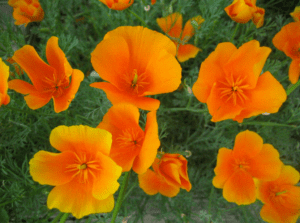
The California poppy, scientifically known as Eschscholzia californica, is the official state flower of California and a symbol of the state’s natural beauty. This vibrant flower is native to the Pacific slope of North America, stretching from Western Oregon to Baja California, and has adapted to various environments across the Western United States.
Description
Appearance: The California poppy grows upright, reaching 12 to 24 inches. It features feathery, blue-green leaves and produces four delicate petals ranging from bright orange to pale yellow. The flowers are known for their satiny texture and distinctive darker centers.
Growth Habit: This plant can be an annual or perennial, depending on the climate. In milder regions, it may survive for several years, while in colder areas, it behaves as an annual, reseeding itself each year. The California poppy thrives in well-drained, sandy soils and requires full sun for optimal growth.
Blooming Season: The blooming period typically occurs from February to September, with the most vibrant displays seen in spring. The flowers are phototropic, closing at night and during cloudy weather, which can limit their visibility on overcast days.
Gerbera Daisies (Gerbera jamesonii)
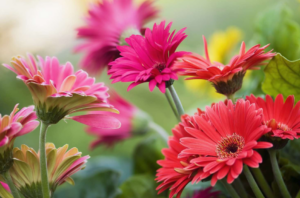
Gerbera daisies, scientifically known as Gerbera jamesonii, are vibrant flowering plants belonging to the Asteraceae family. Commonly referred to as the Barberton daisy or Transvaal daisy, these flowers are renowned for their striking colors and large, showy blooms, making them a popular choice in gardens and floral arrangements.
Botanical Characteristics
Gerbera jamesonii is native to South Africa, particularly the Transvaal region, and thrives in warm, sunny climates. The plant typically reaches a height of 12 to 18 inches and features a rosette of dark green, lobed leaves from which tall stems rise, bearing flowers ranging from 2 to 6 inches in diameter. The petals come in various colors, including red, pink, orange, yellow, and white, often with contrasting central disks.
Growth and Care
Gerbera daisies are considered tender perennials in warmer climates but are often cultivated annually in regions with cold winters. They prefer well-drained, moist soil and full sun exposure. Regular watering is essential, especially during dry periods, but care must be taken to avoid overwatering, which can lead to root rot. Fertilization with a high-phosphorus, low-nitrogen fertilizer every two weeks during the growing season is recommended to promote healthy blooms.
Chrysanthemums (Chrysanthemum morifolium)

Chrysanthemums, scientifically known as Chrysanthemum morifolium, are popular flowering plants in the Asteraceae family. They are commonly called “mums” or “chrysanths” and are native to East Asia, particularly China, where they have been cultivated for over 3,000 years. These herbaceous perennials are celebrated for their vibrant blooms, which come in a wide range of colors including yellow, white, pink, red, and orange, and various forms such as pompon, spider, and anemone types.
Characteristics
Genus: Chrysanthemum
Species: C. × morifolium
Family: Asteraceae
Chrysanthemums typically grow to 1 to 3 feet and can spread 1 to 2 feet wide. They thrive in full sun and well-drained soil, preferring a neutral pH between 6.0 and 8.0. The plants are known for their dense, erect, and mounding growth habit, with deeply lobed dark green leaves that add texture even when not in bloom.
Cultural Significance and Uses
Chrysanthemums hold various cultural meanings, symbolizing love, joy, and celebration. They are particularly significant in Asian cultures, featuring prominently in festivals such as the Chrysanthemum Festival in Japan. In addition to their ornamental value, the petals and flower buds are used in traditional Asian cuisine to make teas and wines.
Carnations (Dianthus caryophyllus)
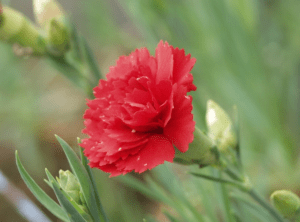
Dianthus caryophyllus, commonly known as the carnation, is a perennial flowering plant native to the Mediterranean region. It is widely cultivated for its vibrant flowers and distinctive spicy fragrance, often described as clove-like. The plant has been appreciated for over two millennia, with its name derived from the Greek words for “divine” (Dios) and “flower” (anthos), as well as the Latin term for “crown” or “garland” (corona), reflecting its historical significance in various cultures.
Characteristics
- Family: Caryophyllaceae
- Height: Typically ranges from 6 to 24 inches tall.
- Bloom Time: Primarily blooms in spring and early summer.
- Flower Colors: Available in various colors including white, pink, red, yellow, and purple.
- Soil Requirements: Prefers well-drained, alkaline to neutral soil with a pH of 6.0 to 7.0.
- Light Requirements: Thrives in full sun to partial shade, although excessive afternoon sun can cause petal fading.
Growing Conditions
- Hardiness Zones: Typically suited for USDA zones 7 to 10.
- Temperature: Prefer cooler conditions and may struggle in extreme heat.
- Fertilization: A small amount of slow-release fertilizer can be beneficial, but over-fertilization should be avoided to prevent root damage.
Cultural Significance
Carnations hold various meanings across cultures, often symbolizing love, fascination, and admiration. They are particularly associated with Mother’s Day in the United States, where pink carnations are used to honor mothers. The flowers are also edible, adding a unique flavor and color to culinary dishes.
Uses
Beyond ornamental purposes, carnations have been utilized in traditional herbal medicine for their potential health benefits, including treatments for fevers and as a source of essential oils. Their fragrant blooms are popular in floral arrangements, corsages, and as cut flowers, making them one of the most commercially significant flowers worldwide.
Marigolds (Tagetes spp.)

Marigolds, scientifically classified under the genus Tagetes, are a diverse group of flowering plants belonging to the Asteraceae family. This genus includes approximately 50 species, primarily native to the Americas, particularly Mexico and Central America, but many have been naturalized in other regions worldwide. The genus Tagetes was first described by Carl Linnaeus in 1753.
Botanical Classification
Tagetes species are characterized by their herbaceous nature, with heights ranging from 0.1 to 2.2 meters. They typically feature pinnate green leaves and produce blooms in a variety of colors, including golden, orange, yellow, and white, often highlighted with maroon. The flowers can vary in size, with heads typically measuring between 1 to 6 cm in diameter, comprising both ray and disc florets.
Common Species
Tagetes erecta (African Marigold):
Height: Up to 1.2 meters (4 feet).
Flowers: Large, double, pompon-like blooms in shades of yellow, orange, and creamy white.
Characteristics: Known for its drought tolerance and suitability for hot conditions.
Tagetes patula (French Marigold):
Height: 15-30 cm (6-12 inches).
Flowers: Semi-double to double blooms in various combinations of reds, oranges, and yellows.
Characteristics: Adaptable to poor soils and known for its nematode-repelling properties, making it popular in companion planting.
Tagetes tenuifolia (Signet Marigold):
Height: 30 cm (12 inches).
Flowers: Small, single blooms with a pleasant lemon scent; flowers are edible and often used in culinary dishes.
Tagetes lucida (Mexican Tarragon):
Height: Up to 75 cm (30 inches).
Flowers: Bright golden daisy-like flowers known for their aromatic foliage.
Cultivation and Uses
Marigolds are commonly grown annually, completing their life cycle within a single growing season. They thrive in well-drained, slightly acidic, neutral soils and require full sun exposure. These plants are valued for their vibrant flowers and pest-repelling properties, making them excellent companion plants in gardens.
Medicinal and Agricultural Significance
Various Tagetes species have been studied for their medicinal properties, including their use in traditional medicine for treating muscular pain and digestive issues. Additionally, extracts from marigolds have demonstrated fungicidal and insecticidal activities, contributing to their role in sustainable agricultural practices.
Roses (Rosa spp.)
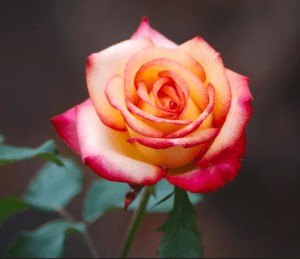
Roses, scientifically classified under the genus Rosa within the Rosaceae family, are woody perennial flowering plants encompassing over three hundred species and thousands of cultivars. These plants are renowned for their beauty and fragrance, making them one of the most popular garden plants worldwide.
Taxonomy and Characteristics
The genus Rosa is characterized by its diverse forms: erect shrubs, climbing, or trailing varieties. The plants typically feature stems armed with sharp prickles and produce large, showy flowers in various colors, including white, yellow, and red. Most species are native to Asia, with some found in Europe, North America, and Northwest Africa. The classification of cultivated roses is complex due to extensive hybridization, leading to a vast array of garden roses.
Etymology
The term “rose” derives from the Latin rosa, which has roots in the Greek word ῥόδον (rhódon) and possibly from the Old Persian word- (words), reflecting the flower’s ancient cultural significance across various civilizations.
Cultivation and Uses
Roses are primarily cultivated for ornamental purposes and appreciated for their aesthetic appeal and fragrance. They thrive best in full sun and well-drained, moist soil. While many roses require diligent care, certain types, such as shrub or landscape roses, are noted for their hardiness and resistance to common diseases. These varieties are often recommended for gardeners seeking lower-maintenance options.
Common Cultivars
Some popular cultivars include:
Knock Out: Cherry-red blooms, disease-resistant, blooms throughout the season.
Little Mischief: Masses of red flowers that fade to hot pink, very disease-resistant.
Rainbow Knock Out: Coral-pink blooms are disease-resistant and bloom all season.
Challenges in Rose Care
Despite their popularity, roses can be labor-intensive, especially hybrid varieties like hybrid tea and floribunda, which are more susceptible to diseases and require specific care. Common issues include black spots, powdery mildew, and insect pests such as aphids and beetles. Proper cultivar selection and good cultural practices are essential for successful rose gardening.
Irises (Iris spp.)

Irises are perennial plants that return yearly, with over 300 species available. They are known for their showy, butterfly-like flowers in various colors, including white, yellow, blue, purple, and bicolor.
Irises can be divided into two main groups based on their growth habit:
Rhizomatous Irises
Grow from creeping underground stems called rhizomes
Examples include bearded irises (Iris germanica), Japanese irises (I. ensata), and Siberian irises (I. sibirica)
Prefer well-drained soil and full sun
Bulbous Irises
Grow from bulbs, especially in drier climates
Examples include Dutch irises (I. hollandica), Spanish irises (I. xiphium), and reticulate irises (I. reticulata)
Also prefer well-drained soil and full sun.
Irises make excellent accent plants for beds, borders, and foundations. They are deer and rabbit resistant, and some species like the Louisiana iris (I. x) can even tolerate wet soils. With their lengthy bloom period from spring through summer, irises are a must-have for any Southern garden.
Sneezeweed (Helenium autumnale)
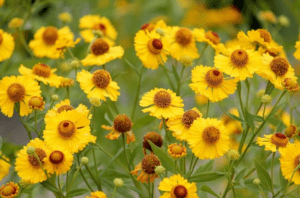
Helenium autumnale, commonly known as sneezeweed, is a perennial flowering plant belonging to the Asteraceae family. It is native to North America and is recognized for its vibrant yellow blooms that typically appear from late summer to fall.
The plant can reach 3 to 5 feet (90 to 150 cm) and features lance-shaped, dark green leaves arranged alternately along its stems. The flowers are composed of bright yellow ray florets surrounding a central disk of smaller florets, which can collectively produce up to 100 flower heads per plant.
Historical and Cultural Significance
The name “sneezeweed” originates from the historical use of its dried leaves to create a snuff that induces sneezing, which was believed to rid the body of evil spirits or alleviate head colds. This plant has been used in various folk remedies. However, it is important to note that the leaves and flowers are toxic if consumed in large quantities, causing gastric irritation and potentially poisoning livestock.
Habitat and Growth Conditions
Sneezeweed thrives in moist environments, often found in wet meadows, along stream banks, and in open woodlands. It prefers full sun and can tolerate a range of soil types, including clay, loam, and sandy soils, provided they are moist but well-drained. This plant is hardy in USDA zones 3 to 9 and is known for its resilience against disease and pests.
Ecological Role
The flowers of Helenium autumnale are particularly attractive to various pollinators, including bees and butterflies, due to their nectar-rich blooms. Unlike many plants that produce light, airborne pollen, sneezeweed has heavy, sticky pollen that does not typically cause allergies despite its misleading name.
Bird of Paradise (Strelitzia reginae)
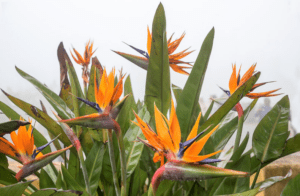
Bird of Paradise, scientifically known as Strelitzia reginae, is a striking flowering plant native to South Africa, particularly found in the Cape Provinces and KwaZulu-Natal. This evergreen perennial is renowned for its unique and vibrant flowers, which resemble the head of a tropical bird, hence its common name. The plant is a member of the banana family, Strelitziaceae, characterized by its large, paddle-like leaves and dramatic floral display.
Description
Strelitzia reginae typically grows between 3.5 to 6 feet tall and 3 to 4 feet wide. The leaves are long-stalked, gray-green, and can reach lengths of up to 18 inches. The flowers emerge from a beak-like spathe, featuring three bright orange sepals and three vivid blue petals, with the petals arranged to mimic a bird’s head and beak.
Habitat and Distribution
This species thrives in mild climates and is often found in coastal regions among shrubs along riverbanks. It is an important nectar source for birds, which also plays a role in its pollination. While it is commonly associated with tropical regions, Strelitzia reginae is cultivated worldwide, particularly in subtropical areas like Southern California and Florida, where it is used as an ornamental plant.
Coneflowers (Echinacea spp.)
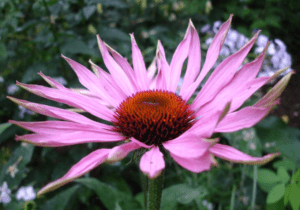
Coneflowers, scientifically known as Echinacea spp., are a genus of herbaceous flowering plants belonging to the Asteraceae family. Native to eastern and central North America, these perennial plants are well-known for their vibrant blooms and ecological benefits.
Taxonomy and Species
The genus Echinacea comprises nine recognized species, including:
Echinacea purpurea (Purple Coneflower)
Echinacea angustifolia (Narrow-leaf Coneflower)
Echinacea pallida (Pale Purple Coneflower)
Echinacea paradoxa (Yellow Coneflower)
Echinacea laevigata (Smooth Coneflower)
Echinacea tennesseensis (Tennessee Coneflower)
Echinacea atrorubens (Topeka Purple Coneflower)
Echinacea sanguinea (Sanguine Purple Coneflower)
Echinacea simulate (Wavyleaf Purple Coneflower)
The name Echinacea is derived from the Greek word ἐχῖνος (ekhinos), meaning “hedgehog,” which refers to the spiny central disk of the flower heads.
Habitat and Distribution
Coneflowers thrive in a variety of habitats, including prairies, open woodlands, and meadows, often in well-drained soils. They are drought-tolerant and can withstand a range of soil types, making them a resilient choice for gardens. Their natural range extends from Canada down to the Gulf of Mexico, predominantly in the Great Plains region of the United States.
Ecological Importance
Coneflowers are not only aesthetically pleasing but also serve as vital resources for wildlife. They attract pollinators such as bees and butterflies and provide seeds for birds like goldfinches after the flowers have faded. Their role in supporting biodiversity makes them a popular choice for gardeners looking to create pollinator-friendly spaces.
Medicinal Uses
Historically, Echinacea has been utilized in traditional medicine, particularly for its purported immune-boosting properties. While many people use extracts of Echinacea as dietary supplements, scientific evidence supporting their effectiveness is limited. Some studies suggest that certain compounds in Echinacea may help prevent infections, although more research is needed to confirm these claims.
Black-eyed Susans (Rudbeckia spp.)
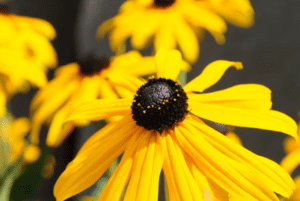
Black-eyed Susans (Rudbeckia spp.) are a group of cheerful, daisy-like flowers native to North America. They are known for their bright yellow petals surrounding a dark brown or black center cone.
Description
Upright, hairy plants growing 1-3 feet tall with lance-shaped, toothed leaves
Large, 2-3 inch flowers with yellow or orange petals and a prominent dark center cone
Flowers bloom from early summer to fall
It may be annual, biennial, or short-lived perennial
Varieties
There are many cultivars with different flower colors, sizes and growth habits:
‘American Gold Rush’: Compact, dome-shaped plants with arching yellow-gold petals, resistant to Septoria leaf spot
‘Goldsturm’: Compact, mounded habit with classic black-eyed Susan blooms, but prone to leaf spot diseases
‘Forever Gold’: Compact plants with starry yellow flowers
‘Autumn Colors’ and ‘Cherry Brandy’: Biennial types with unique colors
Benefits
Attract a wide variety of pollinators like bees, butterflies and moths
Provide food for birds with their nutritious seeds
Long blooming season adds vibrant color to gardens for many months
Hardy, drought-resistant, and easy to grow in various soil types
Excellent cut flowers with a long vase life
Provide winter interest with their seed heads
Black-eyed Susans are versatile plants that work well in many garden styles, from cottage gardens to wildlife meadows. Their cheerful blooms and ecological benefits make them a great addition to any sunny garden in North America.
Sunflowers (Helianthus annuus)

Sunflowers, scientifically known as Helianthus annuus, are a prominent species within the Helianthus genus, encompassing approximately 70 species of flowering plants in the Asteraceae (daisy) family. This genus is predominantly native to North and Central America, with the common sunflower being the most recognized species.
Description
Helianthus annuus is characterized by its tall stature, typically reaching heights of 1.5 to 4.5 meters (5 to 15 feet). The plant features broad, coarsely toothed leaves that are rough and hairy, measuring between 7.5 to 30 cm (3 to 12 inches) in length.
The sunflower’s flower heads, which can exceed 30 cm in diameter in cultivated varieties, comprise numerous tiny florets that form a more giant composite flower. The outer ray florets are usually bright yellow, while the inner disc florets can be yellow, brown, or purple.
Cultivation and Uses
Sunflowers thrive in full sun and are typically grown in well-drained, fertile soils. They are cultivated for various purposes, including:
Edible Seeds: The seeds are rich in oil and are harvested for cooking oil, snacks, and livestock feed. They are also used to produce sunflower oil, which is valued for its culinary uses and is comparable to olive or almond oil.
Ornamental Use: Sunflowers are popular in gardens for their aesthetic appeal, with many cultivars available in colors ranging from traditional yellow to red, bronze, and even white. They are often used in wildlife gardens due to their attractiveness to pollinators like bees and butterflies.
Cultural Significance: The common sunflower is the state flower of Kansas and serves as a symbol of Ukraine, where it has been cultivated for centuries.
Ecological Role
Sunflowers play a significant role in their ecosystems. They provide nectar for various pollinators and serve as a food source for birds and other wildlife. The seeds are beautiful to finches and other seed-eating birds. Additionally, sunflowers can support specialized bee species, contributing to biodiversity.
Coreopsis (Coreopsis spp.)
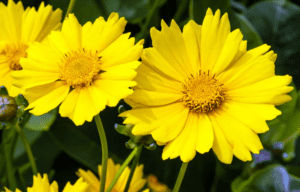
Coreopsis, commonly known as tickseed, is a genus of flowering plants belonging to the Asteraceae family. This genus includes approximately 75 to 80 species, most native to North America, with some also found in Central and South America. The name “Coreopsis” derives from Greek, meaning “bedbug,” due to the shape of its seeds resembling those insects.
Characteristics
Coreopsis plants are celebrated for their bright, daisy-like flowers that bloom in various colors, including yellow, orange, pink, and white. They typically grow between 18 to 48 inches tall, depending on the species, and have a moderate growth rate. The foliage can vary significantly among species, with some having large green leaves while others exhibit narrower foliage.
Flowering and Growth
Coreopsis is known for its long blooming period, generally from early summer to fall. The flowers attract various pollinators, including bees and butterflies, making them a popular choice for gardens aimed at supporting wildlife. The plants are also drought-tolerant and can thrive in poor soil conditions, although they prefer well-drained, sandy soils.
Gladiolas (Gladiolus spp.)

Gladiolas, belonging to the genus Gladiolus, are popular flowering plants known for their tall, striking spikes adorned with colorful blooms. This genus comprises over 300 species, primarily originating from Africa, Madagascar, and Eurasia. They are called sword lilies due to their long, sword-shaped leaves and funnel-shaped flowers that bloom sequentially from the bottom of the spike to the top.
Characteristics and Growing Conditions
Physical Description
Gladiolus plants typically feature:
Height: Ranges from 1 to 6 feet.
Leaves: Long, sword-like, arranged in upright fans.
Flowers: Funnel-shaped, available in various colors, and often fragrant. They are excellent as cut flowers, making them a favorite in floral arrangements.
Dahlias (Dahlia spp.)
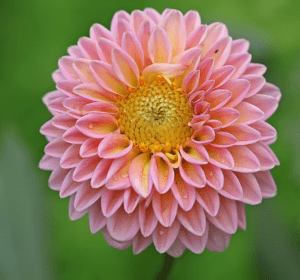
Dahlias, belonging to the genus Dahlia (family Asteraceae), are bushy, tuberous, herbaceous perennial plants native to Mexico and Central America. They are famous for their vibrant flowers, which come in various colors (excluding blue) and forms, making them a favorite among gardeners and florists. There are around 49 recognized species and over 20,000 cultivars of dahlias, showcasing a remarkable diversity in appearance and characteristics.
Botanical Characteristics
Dahlias are characterized by their composite flower heads, consisting of central disc florets and surrounding ray florets. The plants can vary significantly in height, ranging from about 30 centimeters (12 inches) to over 2.4 meters (8 feet). Flower sizes also vary, with diameters from 5 cm (2 inches) to 30 cm (1 foot) for larger varieties known as “dinner plate” dahlias.
Cultivation and Care
Dahlias thrive in well-drained, fertile soil with full sun exposure and require consistent moisture. They are typically planted in spring after the last frost, and their growing season extends from midsummer until the first frost of fall. They are often treated as annuals in colder climates, while in warmer zones, they can be perennial.
Crocosmia (Crocosmia spp.)
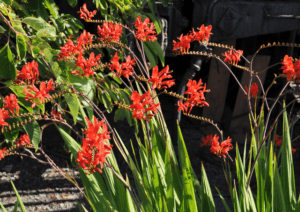
Crocosmia, commonly called Montbretia or copper tips, is a genus in the Iridaceae family, encompassing several species and hybrids. This perennial plant is celebrated for its striking, tubular flowers blooming in vibrant shades of red, orange, and yellow, typically during summer and fall. The flowers emerge from erect, sword-shaped leaves, creating a visually appealing display in gardens.
Characteristics and Habitat
Appearance
Crocosmia plants feature clumps of sword-like leaves from which upright stems bear small, funnel-shaped flowers that bloom successively. The most common colors are orange, yellow, and red, with some varieties exhibiting bronze-tinted foliage.
Native Habitat
Originally native to southern and eastern Africa grasslands, Crocosmia thrives in various soil types and prefers full sun to partial shade. It is adaptable to different climates, typically growing well in USDA hardiness zones 6 to 10.
Growing Conditions
Soil and Watering
Crocosmia prefers well-drained soil that retains some moisture, making it essential to avoid overly dry conditions. It can tolerate various soil pH levels, including acidic, neutral, and alkaline. Watering should be regular but not excessive, as overwatering can lead to root rot.
Helenium (Helenium spp.)

Helenium, commonly known as sneezeweed, is a genus of flowering plants in the Asteraceae family, native to the Americas. This genus includes over 40 species of annuals and herbaceous perennials, with Helenium autumnale being one of the most recognized and widely cultivated varieties.
Characteristics
Helenium plants are characterized by their daisy-like composite flowers, which typically bloom in warm colors ranging from yellow to deep orange and red. The flowers have a distinctive globe-like disk shape, surrounded by wedge-shaped ray florets that often feature notched ends. The plants can grow between 2 to 5 feet tall and are known for their sturdy, upright stems that emerge from a crown of resting shoots with shallow roots
Lion’s Tail (Leonotis leonurus)
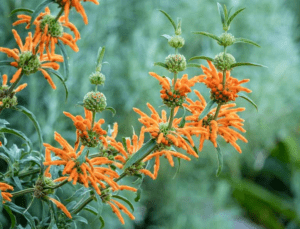
Leonotis leonurus, commonly known as Lion’s Tail, is a semi-evergreen shrub from the mint family (Lamiaceae). Native to South Africa, this plant is notable for its striking orange flowers and adaptability to various growing conditions.
Description
Lion’s Tail typically reaches heights of 4 to 8 feet (1.2 to 2.4 meters) and spreads about 4 to 6 feet (1.2 to 1.8 meters) wide. The plant features lance-shaped, dark green leaves that can grow up to 6 inches (15 cm) long and are aromatic when bruised. The flowers are tubular, two-lipped, and fuzzy, appearing in whorls along the upper half of the stems from late spring through fall.
Gopher Spurge (Euphorbia griffithii ‘Fireglow’)
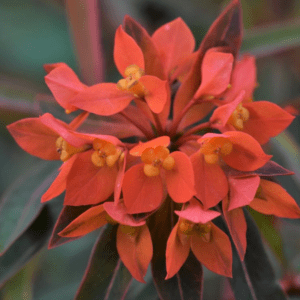
Euphorbia griffithii ‘Fireglow’, commonly known as Gopher Spurge, is a vigorous rhizomatous perennial belonging to the Euphorbiaceae family. This plant is particularly valued for its striking orange-red flowers and attractive foliage, making it a popular garden choice.
Characteristics
- Height and Spread: It typically grows to a height of 2 to 3 feet (60 to 90 cm) and has a similar spread.
- Foliage: The leaves emerge in spring with a rich bronzy-red color, transitioning to mid-green in summer and finally turning crimson red in the fall. The narrow, lance-shaped leaves are borne on upright, reddish stems.
- Flowers: The plant produces vivid orange bracts in umbel-like clusters during early summer, lasting several weeks. These flowers are not only showy but also excellent for cutting.
Angel’s Trumpet (Brugmansia spp.)
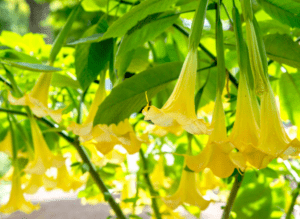
Angel’s Trumpet, scientifically known as Brugmansia spp., is a genus of tropical evergreen shrubs and small trees belonging to the nightshade family, Solanaceae. This plant is renowned for its large, pendulous trumpet-shaped flowers, which can reach lengths of up to 50 cm (20 inches) and come in various colors, including white, yellow, pink, and orange.
The flowers are exceptionally fragrant at night, attracting pollinating moths, although hummingbirds pollinate some species due to their lack of scent.
Characteristics and Growth
Size and Structure
Brugmansia species can grow between 6 to 35 feet tall, depending on the environment and care provided. They typically have a multi-stemmed structure with large, alternately arranged leaves measuring 10 to 30 cm (4 to 12 inches) in length. The plants thrive in well-drained, moist soil and prefer full sun, although they can tolerate partial shade in extremely hot climates.
Care Requirements
Angel’s Trumpet requires ample water and is considered a heavy feeder, necessitating regular fertilization during the growing season. It is best planted in mid-spring when temperatures are consistently above 50°F (10°C) at night. The plant can be grown in containers or directly in the ground, but it is essential to ensure good drainage to prevent root rot.
Orange Siberian Globeflower (Trollius ircuticus)
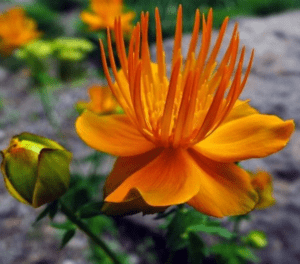
Trollius ircuticus, commonly known as the Orange Siberian Globeflower, is a perennial plant belonging to the Ranunculaceae family. This species is characterized by its vibrant, golden-orange flowers that resemble double buttercups. The blooms typically measure 2.5 inches (6-7 cm) across and are borne on erect stalks above a cluster of deeply divided, dark green leaves.
Habitat and Growing Conditions
The Orange Siberian Globeflower thrives in damp environments, making it suitable for bog gardens, ponds, and streams. It prefers full to partial sun exposure and is notable for its high water needs. The plant is adaptable to various soil types, including clay and loam, and can tolerate poorly drained conditions. It can grow in various soil pH levels, from acidic to alkaline.
Physical Characteristics
- Height: 2 to 3 feet (60 to 90 cm)
- Spread: 1 to 2 feet (30 to 60 cm)
- Hardiness Zones: 3 to 8
- Season of Interest: Late spring to early summer
- Attracts: Butterflies and hummingbirds
- Maintenance: Low
Conclusion
Adding orange flowers to your garden is like inviting sunshine to stay. They bring joy, excitement, and a touch of warmth to any outdoor space. Whether you’re a seasoned gardener or just starting out, there’s an orange flower perfect for you.
From the classic beauty of orange lilies to the cheerful charm of marigolds, these vibrant blooms will transform your garden into a happy haven. So, why wait? Start planning your orange flower paradise today!
Remember: When choosing your orange flowers, consider factors like soil, sunlight, and water needs to ensure they thrive. And don’t forget about the potential toxicity of some plants, especially if you have pets or children.
With a little planning and care, you can create a stunning garden filled with the radiant beauty of orange flowers. Happy gardening!

























